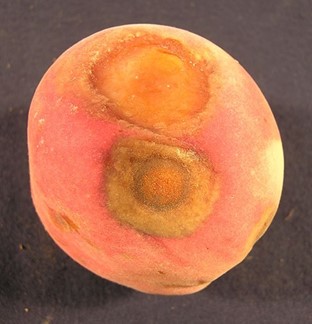Disease Notes
Contact
Plant Diagnostician
Phone: (479) 575-2727
Email: ssmith@uada.edu
Jason Pavel
Diagnostician
Phone: (479) 575-7257
Email: jpavel@uada.edu
University of Arkansas System Division of Agriculture
Cralley Warren Building
Room 16
2601 N. Young Ave.
Fayetteville, AR 72704
Peach – Anthracnose
by Sherrie Smith and Jason Pavel
Two species of Colletotrichum, C. acutatum, and C. gloeosporioides have been found to cause Peach Anthracnose. Find the signs and learn control measures in this disease note update.

Peach Anthracnose – Colletotrichum gloeosporioides
Photo by Sherrie Smith, University of Arkansas Cooperative Extension
What are the signs of Peach Anthracnose?
Symptoms on fruit are circular, sunken, tan to brown, necrotic spots with concentric rings. Ripe fruit is the most susceptible. Lesions are large and firm to the touch. Masses of orange-colored spores occur in the center of the lesions. Warm, wet weather favors disease development. Spores are primarily disseminated by rain and wind. Anthracnose also occurs on plum and sour cherry.
How can you control Peach Anthracnose?
Captan is the fungicide of choice for the control of Peach Anthracnose. Captan can be used in rotation with Quadris Top, Topguard EQ, Pristine, Inspire Super, Indar, Luna Sensation, or Abound. Carefully read the entire product label for restrictions as some of these products can be damaging to nearby apples. The orchard floor and nearby environs should be kept free of weeds and wild prunus.
Take Aways
- Clean up fallen leaves and diseased Fruit.
- Avoid overhead irrigation on young trees.
- Start fungicides from pink bud ripening through harvest.
This work is supported by the Crop Protection and Pest Management Program [grant no. 2017-70006- 27279/project accession no. 1013890] from the USDA National Institute of Food and Agriculture.